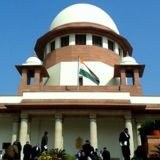Union of India Vs. Kewal Kumar
(From the Judgment and Order dated 14.8.1992 of the Central Administrative Tribunal, Principal Bench, New Delhi in O.A. No. 2737 of 1991.)
(From the Judgment and Order dated 14.8.1992 of the Central Administrative Tribunal, Principal Bench, New Delhi in O.A. No. 2737 of 1991.)
Mr.S.K. Gupta, Mr. R.K. Kamal and Mr. B.S. Gupta, Advocates for the Respondent.
Promotion
Promotion – Sealed cover procedure – Decision to initiate disciplinary proceedings against respondent taken on 20.11.1989 on the basis of FIR filed by CBI – DPC met on 23.11.1989 and followed sealed cover procedure – Chargesheet actually issued to the respondent on 1.8.1990 subsequent to the meeting of DPC – Tribunal, following Jankiraman’s case, held that sealed cover procedure could not be applied as the chargesheet was issued after the DPC met – Held that the Tribunal applied the decision in Jankiraman’s case incorrectly and that the decision to follow sealed cover procedure was fully justified – Office Memorandum No. 22011/2/86- Estt. (A) dated 12.1.1988.
The question to examine in each case, is : Whether, the decision to initiate the disciplinary proceedings had been taken or steps for criminal prosecution initiated before the date on which the D.P.C. made the selection ? The decision would depend on the facts of the case, keeping in view the object sought to be achieved by adopting the sealed cover procedure. It would be incongruous to hold that, in a case like the present, where the C.B.I. had recorded the F.I.R.; sent the same to the superior authorities of the respondent for taking necessary action; and the competent authority had taken the decision, on the basis of the F.I.R., to initiate disciplinary proceedings against the respondent for imposition of major penalty, there can be any doubt that the sealed cover procedure is attracted to avoid promoting the respondent, unless exonerated of those charges. These facts, which led to the adoption of the sealed cover procedure, are undoubtedly very material to adjudge the suitability of a person for promotion to a higher post. A decision to follow the sealed cover procedure in these circumstances cannot, therefore, be faulted.
………………………….
……. In para 2 of the Office Memorandum No. 22011/2/86- Estt. (A) dated 12.1.1988 issued by the Department of Personnel & training, Ministry of Personnel, Public Grievances and Pensions, Government of India, on the subject of procedure and guidelines to be followed in such cases, indicating the situation in which the sealed cover procedure is to be followed, clause (iv) specifies another category. Clause (iv) relates to ‘Government servants against whom an investigation on serious allegations of corruption, bribery or similar grave misconduct is in progress either by the CBI or any other agency, departmental or otherwise’. The fact that the F.I.R. was registered by the C.B.I, and on communication of the same to the departmental superiors a decision had been taken to initiate disciplinary proceedings for imposition of a major penalty, against the respondent in the present case, brings this case squarely within the ambit of clause (iv) of the guidelines, in addition to clause (ii), thereof. (Paras 3, 4 and 6)
2. Union of India and Others v. K.V. Jankiraman and Others, JT 1991 (3) SC = 1991 (4) SCC 109 – Explained and Relied. (Paras 1 & 2)
1. The respondent, Kewal Kumar, was Deputy Chief Electrical Engineer, Northern Railway at New Delhi when the Departmental Promotion Committee (D.P.C.) met on 23.11.1989 for considering the respondent and some others for promotion to the Senior Administrative Grade. The D.P.C. followed the sealed cover procedure in the case of the respondent, in view of the fact that the decision to initiate disciplinary proceedings against him for imposition of major penalty had been taken by the competent authority earlier, on 20.11.1989. The decision to initiate disciplinary proceedings was taken on the basis of a First Information Report (F.I.R.) registered on 30.9.1988 by the Central Bureau of Investigation (C.B.I.) which was received by the concerned departmental authorities on 31.5.1989. Even though the decision was so taken on 20.11.1989 on the basis of the F.I.R. made much earlier, the chargesheet was actually issued to be respondent on 1.8.1990. The respondent challenged before the Central Administrative Tribunal, Principal Bench, New Delhi, the action of the D.P.C. to follow the sealed cover procedure in his case. The Tribunal has accepted the respondent’s claim and allowed his application holding that the sealed cover procedure could not be followed in view of the decision in Union of India and Others v. K.V. Jankiraman and Others.1 The Union of India has challenged that decision by special leave, in this appeal.
2. The decision in the present case, is : Whether the decision in Jankiraman was correctly applied in the present situation? In Jankiraman itself, it has been pointed out that the sealed cover procedure is to be followed where a government servant is recommended for promotion by the D.P.C., but before he is actually promoted if ‘he is either placed under suspension or disciplinary proceedings are taken against him or a decision has been taken to initiate proceedings or criminal prosecution is launched or sanction for such prosecution has been issued or decision to accord such sanction is taken’. Thus, the sealed cover procedure is attracted even when a decision has been taken to initiate disciplinary proceedings, or ‘decision to accord sanction for prosecution is taken’ or ‘criminal prosecution is launched or ….. decision to accord sanction for prosecution is taken’. The object of following the sealed cover procedure has been indicated recently in the decision in Civil Appeal No.1240 of 1993 – Delhi Development Authority v. H.C. Khurana – pronounced on April 7, 19932, and need not be reiterated.
3. It is obvious that when the competent authority takes the decision to initiate a disciplinary proceeding or steps are taken for launching a criminal prosecution against the government servant, he cannot be given the promotion, unless exonerated, even if the government servant is recommended for promotion by the D.P.C., being found suitable otherwise. In a case like the present, where the First Information Report was registered by the Central Bureau of Investigation, and on that basis the decision had been taken by the competent authority to initiate disciplinary proceedings for imposition of major penalty on the respondent prior to the meeting of the D.P.C., the applicability of the sealed cover procedure cannot be doubted. The formulation of the charges required for implementing the decision of the competent authority to initiate the disciplinary proceedings, is satisfied in such a case by the recording of the First Information Report by the Central Bureau of Investigation which records the allegations against the respondent, and provides the basis for disciplinary proceedings. The requisite formulation of the charges, in such a case, is no longer nebulous, being crystallised in the F.I.R. itself and, therefore, even if the chargesheet was issued by its despatch to the respondent subsequent to the meeting of the D.P.C., this fact alone cannot benefit the respondent.
4. The question to examine in each case, is : Whether, the decision to initiate the disciplinary proceedings had been taken or steps for criminal prosecution initiated before the date on which the D.P.C. made the selection ? The decision would depend on the facts of the case, keeping in view the object sought to be achieved by adopting the sealed cover procedure. It would be incongruous to hold that, in a case like the present, where the C.B.I. had recorded the F.I.R.; sent the same to the superior authorities of the respondent for taking necessary action; and the competent authority had taken the decision, on the basis of the F.I.R., to initiate disciplinary proceedings against the respondent for imposition of major penalty, there can be any doubt that the sealed cover procedure is attracted to avoid promoting the respondent, unless exonerated of those charges. These facts, which led to the adoption of the sealed cover procedure, are undoubtedly very material to adjudge the suitability of a person for promotion to a higher post. A decision to follow the sealed cover procedure in these circumstances cannot, therefore, be faulted.
5. It is unnecessary in the present case to discuss at length the decision in Jankiraman to indicate its inapplicability to the respondent, since it has been done in the recent decision in Civil Appeal No.1240 of 1993 – Delhi Development Authority v. H.C. Khurana – pronounced on April 7, 19932.
6. We may also advert to another aspect of this case. In para 2 of the Office Memorandum No. 22011/2/86- Estt. (A) dated 12.1.1988 issued by the Department of Personnel & training, Ministry of Personnel, Public Grievances and Pensions, Government of India, on the subject of procedure and guidelines to be followed in such cases, indicating the situation in which the sealed cover procedure is to be followed, clause (iv) specifies another category. Clause (iv) relates to ‘Government servants against whom an investigation on serious allegations of corruption, bribery or similar grave misconduct is in progress either by the CBI or any other agency, departmental or otherwise’. The fact that the F.I.R. was registered by the C.B.I, and on communication of the same to the departmental superiors a decision had been taken to initiate disciplinary proceedings for imposition of a major penalty, against the respondent in the present case, brings this case squarely within the ambit of clause (iv) of the guidelines, in addition to clause (ii), thereof.
7. Following of the sealed cover procedure in the present case was, therefore, fully justified and the Tribunal committed an error in interfering with that action of the Government.
8. Consequently, the appeal is allowed, the impugned order of the Tribunal is set aside, resulting in dismissal of the respondent’s application made to the Tribunal. No costs.



